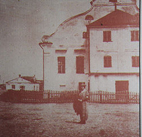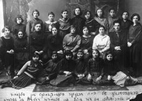 Click
below to view the pages for each family Click
below to view the pages for each family |
 Display/Hide All
Display/Hide All
 Chaiken
Family of Nezhin Chaiken
Family of Nezhin
 Chazanov
Family of Nezhin Chazanov
Family of Nezhin
 Fine
Family of Bialystok Fine
Family of Bialystok
 Geffen
Family of Vilkomir Geffen
Family of Vilkomir
 Goldberg
Family of Jablonka Goldberg
Family of Jablonka
 Katz/Hollander
Family Katz/Hollander
Family
 Zavelsky
Family of Glukhov Zavelsky
Family of Glukhov
| Click
here to see an aerial view of Vilkomir and a town map from 1911 |

| Click
here to view The History Place™Holocaust Timeline. This
is a very important site....slow loading |
| Click
here to look up information on a Shtetl you may recall hearing
about. |
|
| Vilkomir is 43 miles north of Vilna and
30 miles east of Keidan on the Shventa River, a tributary
of the Nieman. The river divides the city into the new and
the poorer section "across the river" A bridge connected
the two.
Our Geffen ancestors lived "across the river"
The city was called Wilkomierz by the Poles, Vilakomir by
the Russians and Vilkmerge, later Ukmerge, by the Lithuanians.
The name appears to be associated with wolves, "vilkas,"
found in the forest of the area.
The city dates from the thirteenth century. Jewish settlement
began in the seventeenth or late sixteenth century. A document
from 1665 gives the Jewish population at 622. The Jews then
were permitted to build a synagogue "across the river,"
and were given a plot for a cemetery.
We believe that our earliest Geffen ancestors were born in
Vilkomir during the mid 1700s.
The Jews concentrated "across the river," and on
the streets near the river. The Christians lived in other
areas. In 1766, 716 Jews lived there. In 1797, all of Vilkomir
District had 6088 Jews. In 1864, the Jewish population of
the city was 4561; there were two synagogues and 12 minyans.
The 1897 census shows 7287 Jews lived there, 53% of the general
population. In 1914, the Jewish population reached 10,000.
The town benefited from its geographical location on a crossroads
and also on the Shventa River. In the early days, the river
was open to navigation. By the nineteenth century, sandbars
blocked the river to all but rafts.
Vilkomir Jews worked as woodcutters and dealers in wood. They
also traded in wheat and flax which they transported on rafts
on the river. They became more involved in trade when they
came in contact with the many Jewish merchants passing through
the town on their way to the big trade centers.
Our documents show that many of the Geffens were tradespeople;
butchers, bakers, winemakers, printers, etc. Beginning in
the mid 1800s migration began to surrounding areas of Vilkomir
such as Jonava, Kaunas and Vilnius. From 1870 on emigration
began to England, South Africa and America.
In May 1915 the Jews were expelled from Ukmerge, together
with those in Kovno. After the war many Jews returned. A yeshiva
ketannah (preparatory yeshiva) was established as well as
two secondary schools for Hebrew and Yiddish. R. Joseph Zussmanowitz,
born in Palestine and ranked as the most prominent Lithuanian
Rabbi, was the last Rabbi in Ukmerge.
With the annexation of Lithuania to the Soviet Union in 1940,
religious and nationalist Jewish life was systematically destroyed.
A year later, Ukmerge fell into the hands of the Germans.
On September 26,1941, the remaining Jews in Ukmerge,together
with those of the neighboring towns, were assembled in the
nearby Pivona forest and massacred. |
| A Visit to Vilkomir...1933 |
From a letter written
to me by Pearl Graham of London, granddaughter of Chaya Geffen
b.1870 Vilkomir
"I went to Vilkomir in 1933 by train and boat. I met Chaya
my grandmother (for the only time), Pesky my aunt, Henky my
other aunt, her son and I have vague recollections of cousins
who were all waiting to emigrate.
I recall the place to be larger than a village with a large
forest at one end.. It had a police station and one proper
road leading to the main town of Kovno (Kaunas). The forest
was used by holiday makers since it had a number of bungalows
in it. There was also an army camp situated there. A few shops
and a weekly market existed, but the majority of the people
were in subsistence agriculture.
There was a chemist, a Shul - it was mostly Christian though.
A river ran through the place - people bathed in it - boys
would dive from a bridge into the river. There was very little
work so life was tough. A man who lives near me returned recently
and says very little has changed. One evening there was a
gathering with an accordion and dancing. The streets were
unusually lit by electricity. (London had gas at this time)
All the family spoke Yiddish. Border guards were very strict
about papers but we managed okay to cross Europe by speaking
Yiddish since Jews turned up in these places. In Germany I
recall Swastika flags flying throughout the land." |
| The Holocaust Period |
"After the outbreak of W.W.II and
the conquest of Poland by the Germans, Lithuania came under
Soviet rule and at the end of summer 1940 was annexed by the
Soviet Union. Jewish public life came to a standstill.
Three days after the German attack on Russia (June 22, 1941),
the Germans conquered Vilkomir. The town was full of Jewish
refugees from western Lithuania.
Local Lithuanians broke into Jewish houses, looted them, harassed
the Jews and killed a number of them. The Jews were accused
of having caused the death of two German soldiers who were
killed by stray bullets.
German soldiers expelled doctors and nurses from the Jewish
hospital and arrested lawyers and public figures. All were
taken to the prison yard and brutally tortured. Finally they
were all murdered in the Russian Orthodox Cemetery. The Lithuanian
head of the secret police and citizens of the town, all known
to the Jews, took part in the torturing and murder.
At the beginning of August, 1941, a ghetto was closed off
in the poor section of Vilkomir; the Germans ordered the Jews
to assemble there within twelve hours. On September 5, 1941,
6,437 men, women and children, the Jews of Vilkomir and its
vicinity, were murdered in the Pivona Forest.
On September 26, 1941, German soldiers and Lithuanian policemen
surrounded the ghetto, and all its inhabitants were taken
to the Pivona Forest where they were mowed down by machine
guns. Their bodies were covered with earth where they had
fallen."
Click
here to go to The Steven Spielberg's Jewish Film Archives
Virtual Cinema
Click here
to see additional photos of the Holocaust Memorial in Vilkomir |
|
|
 |
| #1..The banks
of The Shventa River in Vilkomir 1914. |
 |
| #2..The Great
Synagogue in Vilkomir 1924. |
 |
#3..Kovno Street,
the central street in Vilkomir early 1900s
Boris Feldblyum Photographic Collection |
 |
| #4..Bath Street
in Vilkomir |
 |
| #5..Former Jewish
Cemetery in Vilkomir with a marker and one tombstone. |
 |
| #6..Memorial
erected by the survivors from the Vilkomir community, at the mass
killing fields in Vilkomir where the Jews were murdered during the
Holocaust. Click here
for larger memoial photos |
 |
| #7..Motel
Geffen, b.1858 in Vilkomir, with his family, 1910 Vilkomir. Motel
was a bookbinder, the son of Chaim David, the winemaker. Click
here for larger photo |
 |
| #8..The
"Old People's Home" in Vilkomir taken on July 10, 1928 |
 |
| #9..Teachers
and students in Vilkomir at the Professional School which was supported
by the Relief Committee of Vilkomir Landsleit in Chicago |
 |
| #10..First
meeting of the "Hisdadruth Hechalutz" (a Zionist group)
and delegates of the area. |
 |
| #11..Children's
Orphanage in Vilkomir, July 30, 1924. |
 |
| #12..1926 Vilkomir
School Photograph.
Click here for a 1929 Schiool Photograph. |
|









